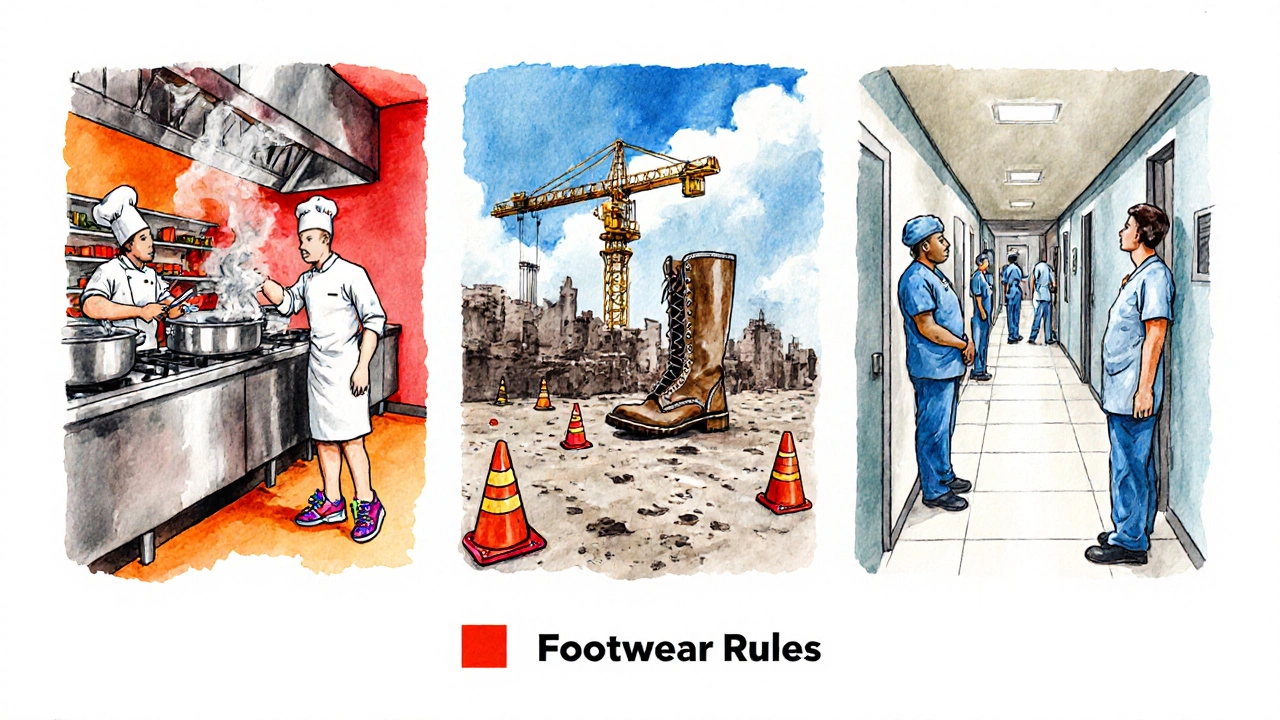UK Footwear Compliance Checker
Is Barefoot Work Compliant?
Answer these questions to check if barefoot work is compliant with UK health and safety regulations for your specific workplace.
Ever wondered if walking around the office or factory without shoes could land you in hot water with regulators? The short answer is: it depends on where you work, what you’re handling, and which rules apply. Below we break down the legal landscape, explain the most common sector rules, and give you a simple checklist to keep your workplace compliant.
What the law actually says
In the UK, the backbone of health‑and‑safety regulation is the Health and Safety at Work etc. Act 1974 (the primary legislation that requires employers to ensure a safe working environment). While the Act itself does not name footwear, it imposes a general duty on employers to provide personal protective equipment (gear designed to safeguard workers from specific hazards) where a risk exists.
The Health and Safety Executive (the UK regulator that enforces health‑and‑safety law) publishes Approved Codes of Practice (ACoPs) and guidance notes that translate the Act into everyday practice. In most cases, the guidance boils down to a simple question: Is there a risk of injury if you’re barefoot? If the answer is yes, employers must provide suitable PPE - typically safety shoes or boots.
Industry‑specific rules you need to know
Some sectors have explicit standards that go beyond the generic duty. Below is a quick run‑through of the most common ones.
- Food and catering: The Food Standards Agency (the body that sets hygiene standards for food handlers) requires non‑slip, closed‑toed footwear in any area where food is prepared, stored, or served. Barefoot is a clear breach of the food hygiene regulations.
- Construction: The Construction (Design and Management) Regulations 2015 mandate protective footwear where there’s a risk of falling objects, punctures, or crushing injuries. Barefoot work is prohibited on most sites.
- Healthcare: While some clinical areas allow shoes with easy‑to‑clean soles, emergency departments and operating theatres often require slip‑resistant shoes to protect both staff and patients.
- Manufacturing & warehouses: Any environment with moving machinery, heavy loads, or chemical spills will have a specific footwear requirement outlined in the employer’s risk assessment.
- Office settings: Unless there’s a specific hazard (e.g., glass shards, wet floors), many offices treat footwear as a matter of personal comfort rather than a statutory requirement.

When going barefoot might be acceptable
Not every job needs shoes. Some low‑risk roles, especially in creative studios, tech start‑ups, or home‑based work, allow employees to ditch the shoes as long as no hazard is present. The key is documentation. Your employer should have a written risk assessment that explicitly states “no PPE required for this role because the risk of foot injury is negligible.” Without that written evidence, you could still be asked to wear shoes if a manager deems it safer.
How to build a clear footwear policy
Creating a policy that satisfies regulators and keeps staff happy is easier than you think. Follow these steps:
- Identify every work area and the associated hazards (slip, impact, puncture, chemical).
- Consult the relevant guidance - HSE ACoPs, FSA regulations, construction CDM rules, etc.
- Classify zones as Protected Footwear Required or Footwear Optional.
- Specify the type of PPE needed (e.g., steel‑toe boots, slip‑resistant shoes, non‑conductive soles).
- Communicate the policy in writing, post signage in each zone, and keep records of employee acknowledgments.
- Review the policy annually or whenever a new hazard is introduced.
Remember to keep a spare pair of safety shoes on site for visitors or contractors who might forget theirs.
Potential consequences of non‑compliance
If an inspector from the Health and Safety Executive finds that employees are working barefoot where protective footwear is mandated, the business could face:
- Improvement notices - written orders to fix the breach within a set timeframe.
- Prohibition notices - stopping work until the hazard is removed.
- Prosecutions - fines up to £20,000 per offence for most breaches, and higher penalties for severe injuries.
- Increased insurance premiums - insurers view health‑code violations as a risk factor.
Beyond legal repercussions, the hidden cost is staff injury. A simple slip on a wet floor can lead to a broken toe, time off work, and workers’ compensation claims.
Sector comparison at a glance
| Sector | Is barefoot allowed? | Typical protective footwear | Key regulator / guidance |
|---|---|---|---|
| Food & catering | No | Slip‑resistant, closed‑toed shoes | Food Standards Agency (Hygiene Regulations) |
| Construction | No | Steel‑toe boots, puncture‑proof soles | Construction (CDM) Regulations 2015 |
| Manufacturing | No | Impact‑resistant shoes, chemical‑resistant boots if needed | Health and Safety at Work etc. Act 1974 |
| Healthcare | Rarely | Slip‑resistant, easy‑clean shoes | HSE Guidance on PPE for Health Care |
| Office/creative studios | Yes, if no hazard | None required (risk assessment must confirm) | Employer’s risk assessment |
Quick checklist to avoid a barefoot health code violation
- Have you completed a risk assessment for each work area?
- Do the relevant regulations (HSE, FSA, CDM) demand protective footwear?
- Is your footwear policy documented and signed off by staff?
- Are signs posted at zone entrances reminding workers of footwear rules?
- Do you keep a spare pair of safety shoes for unexpected visitors?
Frequently Asked Questions
Can I be fined for being barefoot in a restaurant kitchen?
Yes. The Food Standards Agency requires non‑slip, closed‑toed shoes in any food‑handling area. An inspector can issue an improvement notice and, if not remedied, the business may face fines.
Do UK offices have a legal duty to provide shoes?
Only if a genuine foot‑injury risk exists. In a typical office with carpeted floors and no hazardous equipment, there is no statutory requirement. However, an employer can still set a policy for consistency or insurance reasons.
What should I do if I’m unsure whether my role needs safety shoes?
Ask your line manager for the written risk assessment. If none exists, request one - it’s the employer’s legal duty to produce it.
Are there any exemptions for religious or cultural reasons?
Exemptions can be considered, but the employer must still demonstrate that the risk of injury is mitigated in another way (e.g., protective floor mats). The HSE expects a balanced approach that respects both safety and diversity.
How does the US OSHA standard differ from UK rules?
OSHA also mandates protective footwear where a hazard exists, but it explicitly references the General Industry Standard 1910.136. The UK relies on risk assessments under the HSWA, so the key difference is the level of prescriptive detail.

